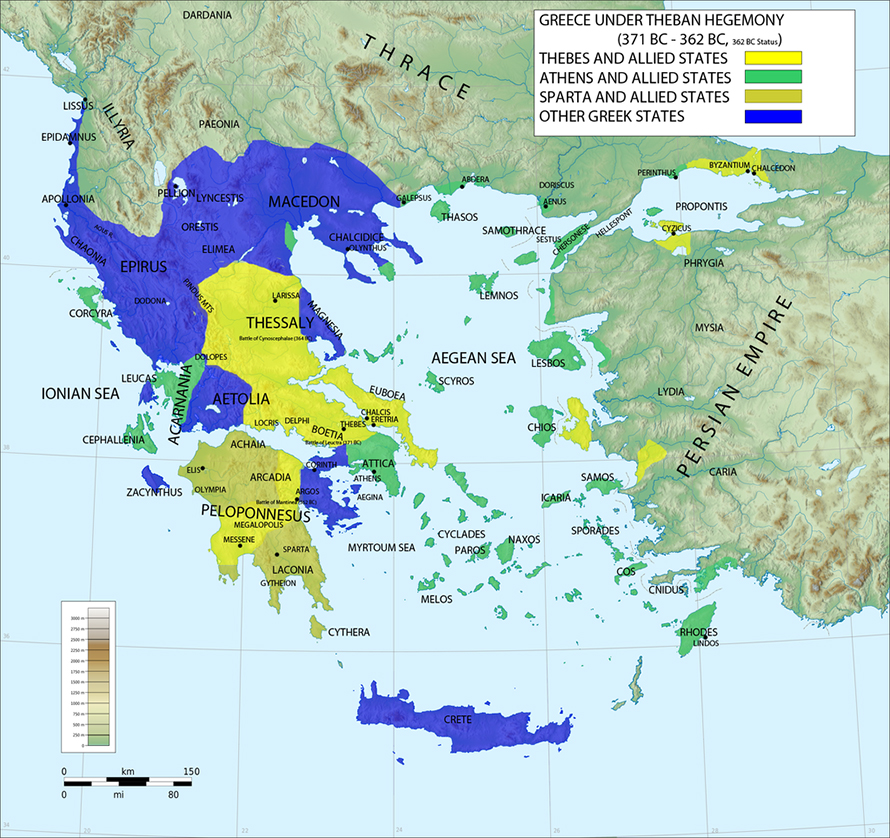In Boeotia (region of the central Greece in ancient times known as a large crop area), dozen city-states were established. The most oldest and popular among them was Orchomenus, and later the first place in Beotia had Thebes. According to legend Thebes were founded by King Cadmus, around the acropolis (citadel) Cadmeia. At the initiative of the Thebans in 447 BC Alliance of Boeotians was founded, where all the Boeotian cities accessed and which was established for the common foreign policy and a common defense. Boeotia was divided into 11 areas. Each area was given 1,000 pedestrians and 100 cavalrymen with beotarhom headed. The Alliance had Assembly (660 deputies, 60 from each area), and the executive branch had 11 beotarch. Each polis had 4 councils that were determined by the property census.
Boeotians in the Peloponnesian War, were allies of Peloponnesians and fiercely fought against Athenian hegemony. Later, as the Athenian allies they fought against Spartan hegemony. The Spartans forced Thebans to disband the Boeotian alliance, but failed. Spartans in the 382 BC took Thebes, from which they were evicted three years later when the Boetians alliance was renewed. It was followed by a bloody battle that culminated in 371 BC at the Battle of Leuctra. In that battle the Boeotians, thanks to the new military tactics commanders defeated a much stronger army of the Spartans and their allies.



Theban aristocrat Epaminondas became beotarch in the 371 BC. Until his death, Epaminondas was a strategist and a first Thebas statesman. He led the army at the Battle of Leuctra against Sparta.
Pelopidas – pointed as the leader of patriots who in the 379 BC expelled the from the Theban acropolis Cadmeia and liberated the city.
Victory of Epaminondas army at Leuctra destroyed the Spartan hegemony and unbridled Peloponnesian Alliance. The members of the Peloponnesian League, that were previously dependent on Sparta, started to become independent and grouped according to interests. Now the Thebans established its hegemony in Greece, that was based on the wars. Epaminondas conducted 4 military marchs against the Peloponnese, where the Acradians battled for supremacy (Epaminonda founded Arcadia Association and city Megalopolis) and Spartans, and Messenia was released from the Spartan authorities. Greek cities assembled and broke alliances depending on current needs. There were many battles. The result was the battle of Mantinea (362 BC), in Arcadia. Epaminondas in 362 BC broke into the Peloponnese with the Theban army, Locrians and Euboeans. He came to Sparta, then retreated to Mantineia, where he again defeated the Spartans, applying the same tactics as in Leuctra. In the Battle of Mantinea Epaminondas was killed. The Thebans, depressed by his death concluded peace with the status quo and had withdrawned from the Peloponnese. This completes the Theban hegemony.
Theban hegemony was affirmed and in the north, in Thessaly, where the Theban army by Pelopidas leadership had intervened in favor of one group against another dynasty. Thebans had even interfered in the Macedonian court intrigues and dictating their direction of foreign policy. Macedonians in the 368 BC had to send in Thebes hostages as a guarantee that they would perform their obligations towards to the first Greek city. Among the hostages was Philip, who later became king of Macedonia and won Greece. Struggled with each other for hegemony, the Balkan Greeks had exhausted their strength as they weakened before the coming Philip.
